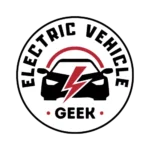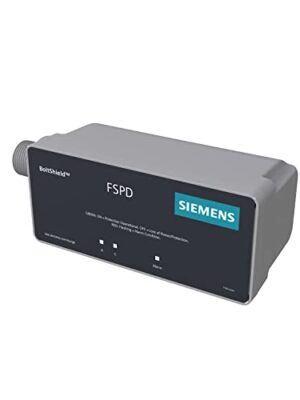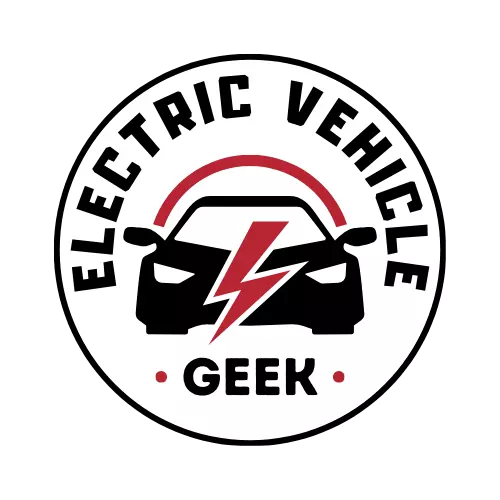EV Chargers Safety Guidelines
At Electric Vehicle Geek, we provide expert-level insights into EV chargers and accessories, including in-depth guidance on EV charger installation practices, circuit wiring diagrams, and the inner workings of high-voltage components. Our content is intended to educate EV owners, installers, and enthusiasts on the safety-critical aspects of EV charging systems.
This guide is intended for educational purposes only and should not replace the expertise of a licensed electrician. EV chargers involve high-voltage systems that require professional installation to ensure both safety and compliance with electrical codes.
Do not attempt to install, open, or modify EV charging equipment or related components, such as breaker panels, smart circuit breakers, surge protection devices (SPD), arc fault EV charger circuit breakers, shunt trip breakers, smart meters, or high-amperage EV charger NEMA outlets, without proper certification. These systems are part of your home’s electrical infrastructure and must be handled according to national standards, EV charger standards, local regulations, and manufacturer guidelines.
All electrical work, including conduit runs, circuit wiring, load balancing, grounding, and mounting, should be performed by a licensed electrician or certified EV charger installer. Even minor errors in EV charger breaker sizing, wire gauge, or device placement can result in fire hazards, equipment failure, or warranty invalidation.
This safety guide is designed to help EV owners, homeowners, and professionals make safe, code-compliant decisions at every stage of the EV charging process, from selecting compatible hardware and planning electric vehicle charging branch circuits to installing accessories and operating equipment responsibly.
If you’re referencing this guide before purchasing or installing EV charging equipment, you’re already taking a smart, safety-conscious step. Our mission is to help you build and maintain a safe, reliable, and durable charging setup that meets long-term performance and compliance goals.
Table of Contents
- Safety Guidelines for EV Chargers and Accessories
- EV Charger Compatibility and Charging Accessories Safety
- Purchase an EV Charger With Built-In Protection Features
- Charging Connector Types and Regional Standards
- Home Electrical Load Compatibility for EV Charging
- Advanced Installations: Solar EV Charging and Load Management
- Onboard Charger Limits and AC Charging Performance
- Communication Protocols and Charging Authentication
- Safety Guidelines by Installation Type
- Read Your EV Manual For EV Charging Guidelines
- Become a Research Pro
- Potential Risks
- Expert Insights Backed by Real-World Experience
Safety Guidelines for EV Chargers and Accessories
This safety guide is designed to help homeowners, EV owners, and licensed electricians make informed, code-compliant decisions about EV chargers and EV charging accessories, from planning and purchase to installation and long-term use.
Whether you’re buying your first electric vehicle, upgrading to a higher-capacity EV charger, or planning a complex installation with advanced accessories such as circuit protection devices, surge protectors, smart meters, or EV charging solar integration hardware, understanding the safety implications at every stage is essential.
Each component in your EV charging system must be properly sized, installed, and certified to operate safely within your home’s electrical infrastructure and meet the technical requirements of your EV. This includes adherence to applicable electrical codes, such as the National Electrical Code (NEC) Article 625 for EV charging systems, NEC 210.19(A)(1) for branch circuit conductor sizing, and NEC 250 for EV charger grounding and bonding.

Improper installation or integration of EV chargers and related accessories can lead to EV charger electrical faults, fire hazards, or premature equipment failure. All work should be carried out by a licensed electrician familiar with EV charging standards and local electrical codes to ensure safety and compliance.
A safe installation begins with proper planning and ends with code-compliant execution.
We strongly recommend reviewing this guide before purchasing or installing any EV charging equipment. Even current EV owners and licensed professionals will find valuable insights in the detailed compatibility checks, EV charging electrical load planning advice, and practical safety tips included here.
The following section incorporates current safety standards, engineering best practices, and real-world installation insights to help ensure safe, reliable, and scalable EV charging at home.
EV Charger Compatibility and Charging Accessories Safety
Choosing the right EV charger and EV charging accessories isn’t just about charging speed or upfront cost; it’s a critical safety decision that must account for your EV’s onboard charger limits, your home’s electrical load for EV charging, and the technical compatibility of every component in your setup.
All EV charging circuit devices and accessories, from the wall charger to surge protectors, outlet enclosures, EV charger pedestals, and EV charging load management devices, must work in harmony.
An incorrectly matched EV charger or accessory can reduce performance, void warranties, or worse, create electrical hazards and code violations. For example, installing a 48A EV charger on a 40A circuit or using indoor-rated enclosures outdoors may compromise reliability and safety.
In this section, we’ll cover how to evaluate EV charger compatibility with your EV, ensure your home electrical panel is capable of supporting the load, and select certified, installation-appropriate accessories that meet both technical and code requirements. We’ll also highlight common pitfalls, such as oversizing chargers beyond your EV’s onboard limit, mismatching wire gauge and breakers, and using uncertified components.
By understanding how charger specs, electrical infrastructure, and accessory ratings must align, you’ll be able to design a safe, scalable, and code-compliant EV charging system, whether for a single home charger or a multi-EV setup with solar, battery storage, and smart load control.
Purchase an EV Charger With Built-In Protection Features
We highly recommend purchasing an EV charger with built-in safety features like temperature sensors, overcurrent and overvoltage protection, short circuit shutdown, ground fault detection, and EV charging surge protection. Smart EV charging logic adds automatic shutoff and safe restart after faults or power loss, ensuring safe, reliable, and worry-free charging at home.
Charging Connector Types and Regional Standards
The type of charging port on your vehicle determines the EV charger plug type it can accept.
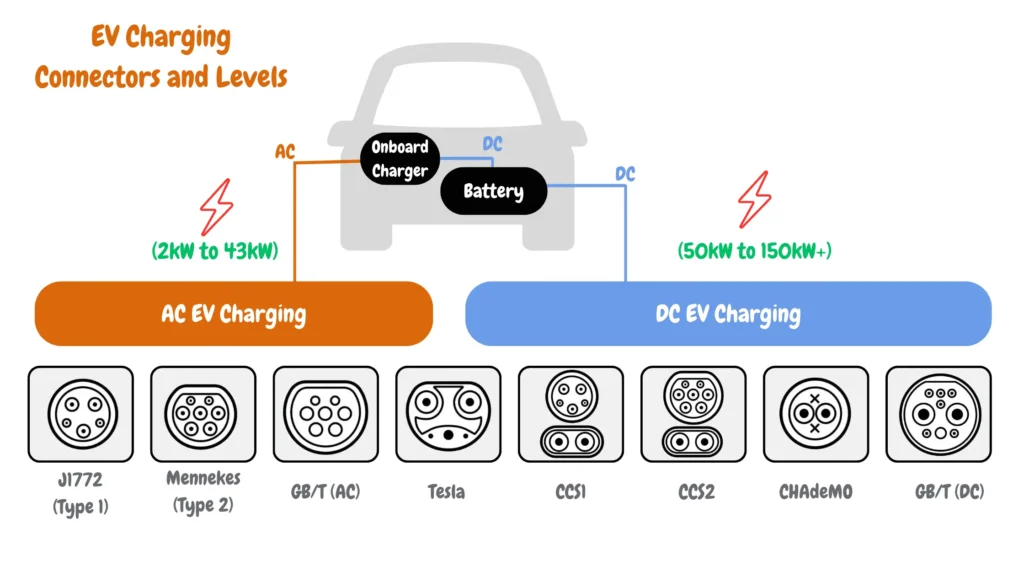
In North America, Level 1 and Level 2 AC charging is typically handled by a J1772 port, while DC fast charging is supported through CCS1. Tesla uses the NACS connector, which is increasingly being adopted by other automakers. In Europe, Type 2 (Mennekes) is the standard for AC, while CCS2 handles DC charging. Japan primarily uses CHAdeMO, while China uses the GB/T standard for both AC and DC.
Although EV charger adapters can offer temporary compatibility between plug types, they often introduce limitations in power delivery and communication reliability, and should only be used with manufacturer-approved configurations.
Home Electrical Load Compatibility for EV Charging
At home, EV owners typically choose between Level 1 and Level 2 AC charging.
Level 1 chargers plug into a standard 120V household outlet and draw 12 to 16 amps, requiring a dedicated 15A or 20A circuit. They deliver around 1.2 kW, adding 3 to 5 miles of range per hour. While this is sufficient for short daily commutes (under 40 miles), charging a large electric vehicle energy storage system from empty may take over 24 hours. Level 1 is most viable for plug-in hybrids, such as the Jeep 4xe, or as a backup option.
Most EV owners upgrade to Level 2 chargers, especially high-amperage hardwired EV chargers rated 48A to 80A, which require a 240V circuit and a 60A to 100A breaker. These chargers deliver 11.5 kW to 19.2 kW, offering 12 to 60 miles of range per hour, depending on the EV’s onboard charger. A typical EV can be fully charged overnight in 4 to 8 hours, while large-battery vehicles (like Rivian, Lucid, or F-150 Lightning) benefit from the faster recovery that 80A units provide.
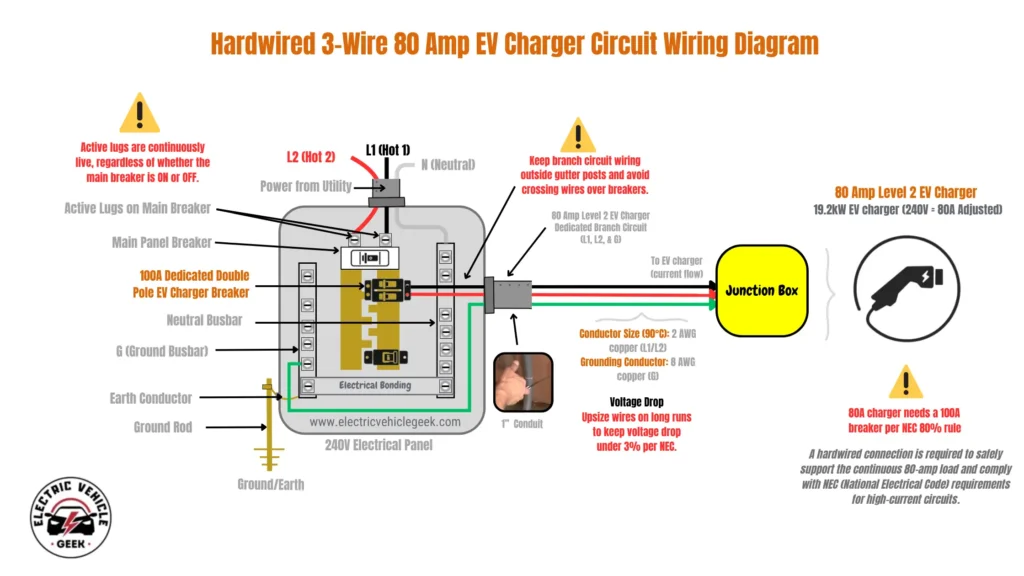
Older homes may lack the electrical capacity to support these higher loads. Panels under 200A often need panel upgrades or load management systems before supporting a 60A–100A EV branch circuit. Attempting installation without a proper load calculation can overload the system, trip dedicated EV charger breakers, or degrade wiring insulation.
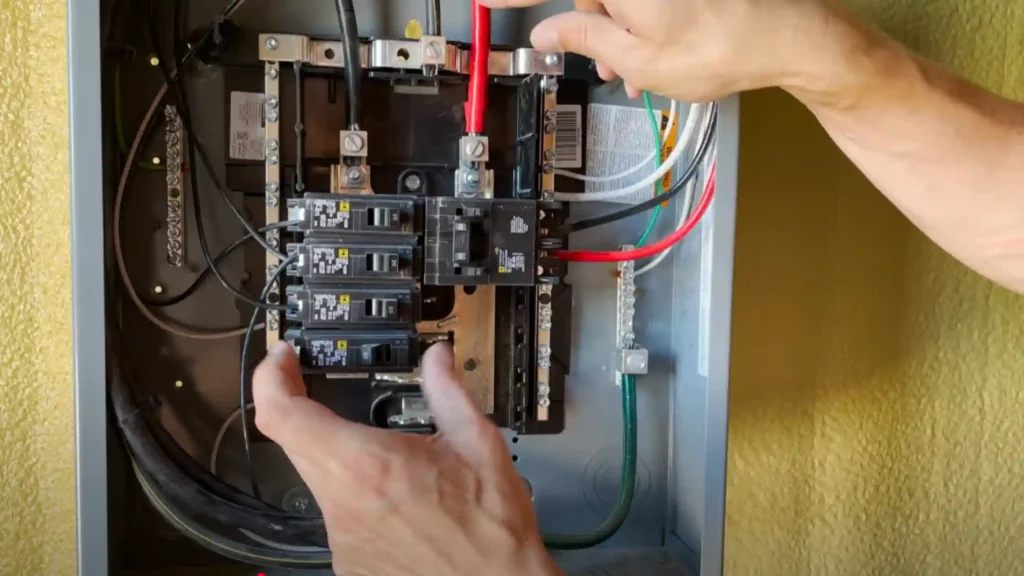
The dedicated EV branch circuit must be properly sized with the correct breaker, wire gauge, and grounding to prevent issues like overheating, voltage drops, or frequent tripping. Purchasing an EV charger that overloads your home electrical load for EV charging not only increases safety risks but may also reduce system efficiency and equipment lifespan.
If you plan to install multiple EV chargers, integrate solar EV chargers, or add high-demand EV charging accessories like battery storage or surge protection devices (SPD), such as the Siemens BoltShield FSPD140 Whole-House SPD with dedicated EV charger circuit breakers, your home electrical panel must be sized to handle the total electrical load and support additional branch circuits for these components.
We use the Siemens BoltShield FSPD140 Whole-House Surge Protective Device (SPD) to protect EV charger installations from high-voltage surges, electrical shocks, and circuit irregularities. It’s an essential safety accessory we recommend for securing any EV charging setup.
As shown in the Siemens BoltShield FSPD140 wiring diagram below, this installation is considered advanced and requires two dedicated circuits and corresponding circuit breakers.
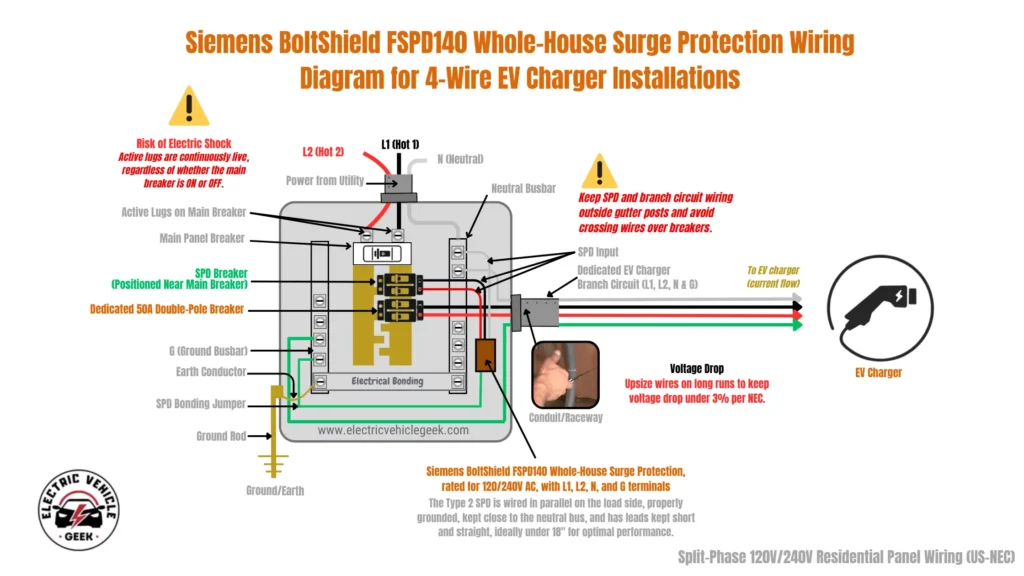
The wiring is extensive, and the total load contribution of the SPD, along with other EV charging accessories, such as the requirements of a second circuit breaker for the SPD device, can significantly increase panel space demands.
For complex EV charging installations, particularly those incorporating multiple accessories, such as surge protection devices (SPDs), smart meters, or energy monitors, a larger electrical panel is often required to handle the increased space and load demands.
When panel space is limited or future expandability is a concern, we recommend mounting certain accessories externally. Devices like the Siemens FSPD140 SPD or smart sub-meters can be installed in weatherproof enclosures adjacent to the panel, provided they meet code requirements and are properly rated for outdoor use. This not only preserves valuable internal panel space but also simplifies servicing and future upgrades.
External mounting improves airflow, reduces thermal congestion inside the panel, and can extend the lifespan of both the accessory and the panel itself. For clean and safe layouts, always keep branch circuit wiring outside gutter posts and avoid routing wires across breakers, as this can obstruct access, create heat buildup, and violate local code requirements.
It’s critical to design your EV charging setup with future scalability in mind. This includes selecting an EV charger, electrical panel, and branch circuit that can support higher amperage, allow for future expansion, and offer smart load-sharing or dynamic energy management capabilities.
Advanced Installations: Solar EV Charging and Load Management
For complex installations, such as solar EV charging involving solar EV chargers, battery storage systems, smart panels, energy monitors, or EV charger pedestals, using components from the same brand ecosystem is a smart safety decision.
Brand-matched systems like the Emporia Pro EV Charger with Vue 3 Home Energy Monitor, Wallbox Pulsar Plus 40 Amp Level 2 EV Charger with the Wallbox Power Meter, or the Tesla Universal Wall Connector with Powerwall are designed for full-stack compatibility.
Within a single EV charger branch circuit, brand-matched chargers and accessories offer superior compatibility, secure communication, and seamless integration. They enable centralized control through a unified app or platform and unlock advanced features such as load management, solar prioritization, and scheduled charging.
Brand matching also enables proprietary features like Tesla’s Power Sharing, a firmware-based function that allows up to six Tesla Gen 3 Wall Connectors to safely share power on a single circuit while charging multiple vehicles. Because all units are designed to work together, they communicate over Tesla’s encrypted protocol, ensuring secure load balancing, firmware compatibility, and system-wide coordination. This closed, unified architecture minimizes risks of misconfiguration, signal interference, and software conflicts common in mixed-brand setups, resulting in a more secure and reliable multi-EV charging solution.
Unified ecosystems also streamline installation, servicing, and maintenance when completed by a licensed electrician or brand-recommended installer. This reduces risks of wiring mismatches, code violations, and connection failures, and makes it easier to pass permitting and inspections under UL Certification, NEC, and local code requirements.
From a digital safety standpoint, staying within one ecosystem improves firmware synchronization, enhances cybersecurity, and protects your EV charging data with stronger privacy protocols. Systems from a single brand are more likely to receive coordinated security updates, minimizing exposure to vulnerabilities as your system scales.
You also benefit from full-system warranty coverage, simplified troubleshooting, and eligibility for home insurance and utility rebates. And as bidirectional charging technologies like vehicle-to-home (V2H) and vehicle-to-grid (V2G) become more common, using a secure, fully integrated charging system, as shown in our Tesla Cybertruck bi-directional EV charging set-up below, is essential for both safety and performance.

Onboard Charger Limits and AC Charging Performance
Your EV’s onboard charger determines how much AC power your vehicle can safely convert into usable DC energy.
This internal component governs the maximum charging rate from any Level 1 or Level 2 AC source.
Even if connected to a high-powered Level 2 charger, your vehicle will only draw as much current as its onboard charger supports. For example, if your EV is limited to 7.2 kW, it will not charge faster on a 19.2 kW charger.
Typical onboard chargers range from 3.6 kW to 11 kW, with some newer EVs supporting up to 19.2 kW. At 7.2 kW, a full charge for a 60 kWh battery might take about 8 to 9 hours; at 11.5 kW, that time drops to around 5 to 6 hours.
However, real-world charging speeds depend on multiple factors: battery state of charge, temperature, cable capacity, and most importantly, your home electrical load for EV charging.
If your home’s electrical panel is undersized or if the branch circuit wiring is not matched to the charger’s amperage, you may face slower charging, tripped breakers, or code violations.
To optimize safety and efficiency, choose an EV charger that closely matches your vehicle’s onboard charger capacity. Oversizing often leads to unnecessary installation costs without any gain in speed. Undersizing can prolong charge times and overwork your home circuit.
Communication Protocols and Charging Authentication
Modern EV charging depends on more than just plug fit and power ratings; it also requires reliable communication between the EV, charger, and backend systems. Before charging begins, every EV and charger performs a digital “handshake” to negotiate voltage, current, and safety parameters.
This process is governed by communication protocols such as ISO 15118 and OCPP (Open Charge Point Protocol). The latest version, OCPP 2.0.1, supports advanced features like dynamic load management, smart charging, remote diagnostics, secure authentication, and future-ready vehicle-to-grid (V2G) functionality.
When choosing a charger, especially for use with home energy systems, smart panels, or solar EV chargers, it’s best to look for OCPP EV chargers that are certified to the latest standard, such as the new Autel Maxicharger 80A EV charger that supports the new OCPP 2.0.1. allowing it to offer more advanced next-generation capabilities, including V2H (vehicle-to-home) and V2G (vehicle-to-grid) bidirectional charging.
OCPP compliant EV chargers ensure optimized and standardized compatibility with utility platforms, third-party apps, energy management systems, and future updates. If communication fails, due to protocol mismatches or unsupported firmware, the charging session won’t start, even if all wiring and hardware connections appear correct.
Between the two OCPP implementations (SOAP and JSON), JSON is the more secure and modern protocol, particularly when paired with proper transport layer protections such as HTTPS and TLS 1.2 or higher. EV chargers that support the latest OCPP standards (OCPP 1.6J and 2.0.1) use JSON over secure WebSockets (OCPP-J), offering stronger encryption, real-time communication, and better support for advanced features like smart charging and remote diagnostics.
In contrast, SOAP-based implementations found in older OCPP 1.5 and some OCPP 1.6S chargers rely on XML over HTTP, making them heavier, less efficient, and more prone to legacy vulnerabilities. For long-term security, performance, and interoperability, OCPP-J is the preferred and future-proof choice.
Safety Guidelines by Installation Type
EV chargers and accessories must be selected to match not only your EV and home electrical load, but also the physical installation environment, particularly whether the setup is indoors or outdoors. Using components not rated for their environment can lead to corrosion, overheating, electrical faults, or fire hazards, while also voiding manufacturer warranties.
Always follow the manufacturer’s specifications for environmental ratings, mounting methods, and electrical compatibility. When in doubt, consult a licensed electrician to ensure the installation is code-compliant, secure, and built for long-term reliability.
Outdoor Installations
Outdoor Installations require more than just weatherproof labels. We recommend chargers with NEMA 4, 4X, or IP65/IP66 enclosures. In coastal or high-rain zones, we’ve seen NEMA 3R housings rust in under a year. EV charger pedestal mounts should be powder-coated steel or anodized aluminum, never uncoated metal. Secure them with stainless steel Tapcon anchors into concrete pads, and apply anti-seize on all bolts to prevent seizure from corrosion. Plastic wall anchors often fail under charger weight and weather stress.
All exterior EV charging accessories, including EV charger lock boxes, pedestals, EV charging outlets (NEMA 14-50 or 6-50), EV charger outlet covers, splitter switches, surge protectors, cable holders, conduit fittings, junction boxes, and weatherproof enclosures, must be certified for outdoor use (UL, ETL, CSA). Use only UV-stabilized polycarbonate or fiberglass-reinforced housings; ABS or indoor PVC often cracks in the sun or cold. EV outlet covers should be gasketed and spring-loaded to fully seal when not in use; many cheaper flip lids leak under wind-blown rain.
Indoor Installations
Indoor Installations still require proper support. Don’t surface-mount directly to drywall. Use ¾” fire-rated plywood over studs or Unistrut framing for wall-mounted chargers. Keep devices clear of heat sources like furnaces. For indoor-only accessories, look for fire-rated, certified components. We often see failures when installers skip strain reliefs on conduit entries, which, over time, pull terminal lugs loose inside chargers.
Read Your EV Manual For EV Charging Guidelines
We strongly recommend every EV owner take the time to thoroughly read their vehicle’s manual, especially the sections covering charging. Your EV’s manual is more than a general reference; it’s the authoritative guide to safely and efficiently charging your specific make and model.
One of the most critical details it provides is the maximum charging power (in kW) your EV can accept. This specification helps you match your vehicle with the correct Level 1, Level 2, or DC Fast Charging equipment. Attempting to charge beyond your vehicle’s onboard capacity won’t speed up charging; it can instead lead to thermal strain, charger faults, or reduced battery efficiency.
We also recommend reviewing the approved connector types for your EV, such as J1772, CCS, CHAdeMO, or NACS. Using incompatible adapters or third-party accessories not listed in the manual can bypass safety checks or cause signal errors between the EV and the charging station.
The manual outlines vehicle-specific charging procedures, such as the correct sequence to plug and unplug, how to activate smart charging features, and how to interpret system feedback like LED indicators or fault codes.
For long-term battery health, we recommend following your manual’s guidance on state-of-charge (SOC) ranges, temperature thresholds, and daily use charging habits, such as keeping the battery between 20% and 80%, and minimizing repeated fast charging when not necessary.
If your EV supports bi-directional charging (V2G or V2H) or software-based features like charging schedules or OTA updates, the manual is the safest and most accurate source for setup instructions.
Become a Research Pro
Before we choose any EV charger or install accessories, we dig through a mix of real-world sources to avoid safety issues, wiring mistakes, or bad purchases. Here’s where we hang out, and the kind of info you’ll find in each spot
Manufacturer Websites and Manuals
This is always our first step. We begin by checking the EV’s manufacturer website or manual for basic information like the maximum supported charging power (in kW or amps), plug type (such as J1772, CCS, or Tesla), and any usage limitations tied to ambient temperature, cable specs, or circuit load.
We also sign up for update alerts and newsletters from EV, charger, and accessory manufacturers. These often include firmware updates, bug fixes, and compatibility notices, such as support for new charging protocols or safety improvements. Staying informed ensures your entire charging system, not just the charger, stays up-to-date, safe, and fully optimized for your EV.
Online Communities
We regularly spend time in communities like r/evcharging, Tesla Owners Club, Mach-E Forum, and Rivian Forums, and they’re absolute goldmines. These online communities are packed with real-world EV chargers and accessories experiences: photos of home installs, creative cable routing ideas, DIY mounting setups, permit challenges, breaker sizing discussions, and honest feedback on charger brands, accessories, and install outcomes.
We also follow trusted electric vehicle content creators on YouTube, which has become a powerful creator-driven online community. Experienced EV owners and licensed electricians often post hands-on walkthroughs, charger reviews, electrical panel upgrades, and long-term product tests. The comment sections serve like mini-forums, where you can ask questions and get personalized feedback from both creators and other owners with the same vehicle or charger.
What makes these communities so valuable is the ability to ask specific questions and get personalized advice from people who’ve already faced your setup, vehicle quirks, or install limitations. We recommend becoming an active participant in communities related to your EV model, charger brand, and installation type.
By staying engaged in online communities, we’ve often received early insights on firmware updates, safety advisories, accessory compatibility issues, and clever install tips that rarely make it into manuals. It’s one of the most efficient ways to stay informed, solve problems early, and make smarter, safer choices with your EV charging setup.
Marketplace Reviews
When shopping for EV chargers and accessories, we rely heavily on verified reviews from marketplaces like Amazon, not just for product ratings, but for real-world, experience-based feedback. These reviews often highlight practical details that manufacturer manuals overlook: unexpected installation challenges, missing tools, overheating issues, or packaging defects.

We’ve seen users mention when a power cable barely reached their preferred outlet, or when a wall mount lacked proper anchors for concrete walls, things that can dramatically affect installation safety and success. This feedback helps us identify both hidden deal-breakers and standout products that hold up better than advertised.
We also use reviews to spot trends, recurring problems like WiFi issues, brittle charging cables, or falsely lack of installation components, such as mounting screws, are often flagged by early adopters.
We recommend reading reviews sorted by most recent and filtering by install type (garage, outdoors, hardwired, etc.). Look for users who mention panel size, wire gauge, and breaker configuration; their feedback often mirrors real installation conditions and can uncover compatibility or code compliance issues.
For us, it’s one of the most valuable, community-driven steps in vetting a charger before purchase.
Reputable EV Blogs & News Sites
EV news platforms like InsideEVs are great for tracking product launches, regulation changes, and breaking developments in the charging space. They provide wide coverage and often surface key issues like charger recalls, new OCPP standards, and evolving tax credit rules before manufacturers make formal statements.
Why We Recommend Electric Vehicle Geek
For EV owners who want not just news but actionable guidance, hands-on product testing, and safety-first recommendations, the Electric Vehicle Geek (EV charging blog) offers something different.
We’re not a media outlet, we’re a team of EV enthusiasts, certified installers, and licensed electricians who test EV chargers and accessories the way you would use them: in garages, outdoors, with different panel loads, conduits, outlets, and mounting configurations. Every product we review is purchased independently, never sent by manufacturers, so there’s no sugarcoating or hidden influence.
What sets us apart is our deep focus on real-world usage and safety. Our lab-built test benches replicate actual Level 2 charging loads and failure scenarios. We don’t stop at spec sheets; we measure heat buildup, overcurrent reactions, NEMA enclosure integrity, and Wi-Fi dropouts under stress conditions. Every product is then installed and field-tested in real environments.
You’ll also find guidance you won’t see on big news sites, like how to size your breaker, how to spot counterfeit NEMA outlets, what type of anchor bolts to use on stucco vs. brick, and how to evaluate accessory safety (like splitter cables, smart adapters, and mounts).
And most importantly, we’re educators at heart. Our goal is to help you avoid electrical hazards, installation mistakes, and wasted money. Whether you’re browsing our charger reviews, outlet recommendations, or installation safety checklists, everything we publish is grounded in industry standards like the NEC, EVITP, NFPA, OSHA, and NEIS.
If you care about safe, code-compliant EV charging, whether you’re a first-time EV owner, a homeowner planning an installation or upgrade, or a contractor seeking reliable, standards-based guidance, Electric Vehicle Geek is the trusted resource we built for you.
Potential Risks
Opening or tampering with EV branch circuit components, chargers, or accessories without formal training poses significant risks that extend beyond basic electric shock. The potential for arc flash events, thermal runaway in conductors or connectors, ground faults, overcurrent conditions, electric vehicle battery fires, and electrical fires is substantial, especially in high-amperage installations. Such interference can compromise not only the safety of the system but also its overall performance and compliance with national electrical codes.
The use of non-compliant or uncertified EV chargers, connectors, or installation hardware introduces a broad range of failure points. Improper wire sizing, often seen in DIY setups, can result in excessive voltage drop, overheating, or insulation breakdown.
One of the most common risks associated with EV charging is outlet melting, especially when EV owners use standard residential outlets instead of industrial-grade EV charging NEMA outlets, which are specifically rated for EV charging (identified by a small green car symbol).
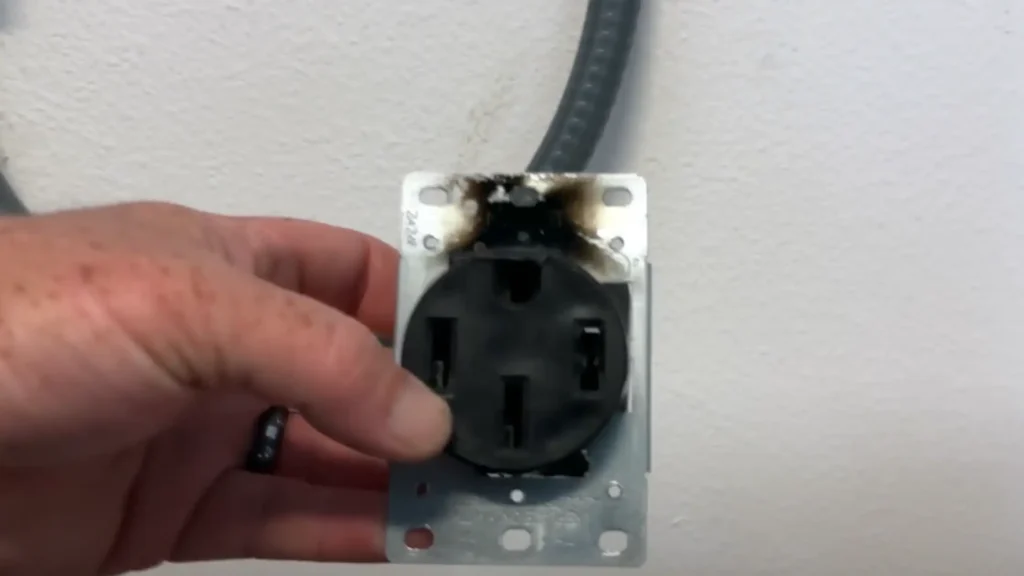
Non-compliant installs, such as undersized wiring, loose terminations, or mismatched materials, can cause excessive heat buildup under continuous load. Over time, this degrades contacts, warps terminals, and may lead to arcing or fire.
These scenarios may lead to nuisance tripping of circuit breakers, overloading of neutral conductors, or permanent damage to the EV’s onboard charger and battery management system.
In substandard EV charger installations, the use of mismatched conductors, such as aluminum in place of copper conductors, paired with incompatible or improperly rated terminal lugs, can create high-resistance connection points. This elevated resistance leads to poor conductivity and excessive heat generation, especially under continuous load. Over time, this thermal stress can degrade insulation, compromise the service panel, damage nearby circuits, and significantly increase the risk of arcing, equipment failure, or electrical fire.
Improper installations can also cause electromagnetic interference (EMI) with other household electronics, especially when grounding and bonding are inadequate or neutral-to-ground voltage differentials occur. In multi-phase systems, unbalanced loads may develop due to poor load calculations or incorrect circuit sharing, which can result in elevated neutral current, excessive heat, and long-term stress on transformers or utility supply lines. In systems with solar or backup power, unintentional backfeed or failure to properly isolate circuits may result in dangerous energization of inactive conductors, putting installers and equipment at risk.
DIY modifications, such as adding EV splitter boxes, bypassing ground fault protection, or connecting multiple chargers to a single circuit, can violate NEC 625, 210, 240, and 300 sections. These code violations not only increase the probability of dangerous faults but also void product warranties, expose homeowners to liability, and can accelerate the degradation of the entire EV charging infrastructure. Long-term effects include overheating of service entrance conductors, damage to terminal connections, arc tracking along insulators, and diminished lifespan of both the charger and the vehicle’s charging components.
To ensure safety, code compliance, and performance, any inspection, installation, or service of EVSE, EV branch circuits, or related components should only be performed by a licensed electrician or a certified EV charger installer who understands the interaction between high-current EV loads and residential or commercial electrical systems.
Not sure if it’s safe? Let a certified EV charger expert guide you.
Expert Insights Backed by Real-World Experience
At Electric Vehicle Geek, our mission is to help you make safe, informed decisions when purchasing and installing EV chargers and accessories. We do this through expert product reviews, practical installation guidance, and public education that encourages smarter charging habits and helps reduce the risk of electrical hazards, equipment failures, and property damage.
What sets us apart is our direct access to real-world experience. Our team includes licensed electricians, certified EV charger installers, and veteran EV owners, all of whom contribute first-hand insights backed by years of field experience. Every team member holds relevant industry certifications and stays at the forefront of EV charging advancements by enrolling in cutting-edge training programs and technology courses.
We also maintain strong relationships with leading EV charger manufacturers, licensed professionals, and industry innovators, regularly exchanging insights and collaborating on the latest best practices, safety protocols, and hardware developments.
Our commitment to continuous learning and collaboration ensures that the information we share is not only accurate and up to date but also grounded in the latest safety standards, installation practices, and technical advancements in EV charging.
As electric vehicle technology evolves rapidly, we regularly maintain and improve our content to reflect new product developments, emerging safety features, practical upgrades, charging performance insights, hardware modifications, and discoveries gained through ongoing field experience. This approach allows us to deliver guidance that is not only timely but also aligned with the highest standards of safety, compliance, and industry best practices.
Our promise to you is built on trust. Every recommendation is grounded in real product testing, hands-on experience, and credible research from authoritative sources, so you can move forward with confidence.

James Ndungu is a certified EV charger installer with over five years of experience in EVSE selection, permitting, and installation. He holds advanced credentials, including certification from the Electric Vehicle Infrastructure Training Program (EVITP) and specialized training in EV charging equipment and installation, as well as diplomas in EV Technology and Engineering Fundamentals of EVs. Since 2021, James has tested dozens of EV chargers and accessories, sharing expert insights into the latest EV charging technologies.
